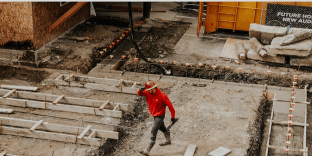
Load Bearing Assessment: When to Consult a Structural Engineer
If you are a homeowner or a property owner, you may have heard of the term “load-bearing wall” and wondered what it means and why it matters.
Well, let us tell you.
A load-bearing wall is a wall that supports the weight of the structure above it, such as the roof or the 2nd or 3rd floor. You’ll see them throughout your house – living spaces, kitchens, dining rooms, etc.
These walls are essential for maintaining the structural integrity and stability of a building. But increasingly, the idea of an open floorplan has been an easy way to create more functional and fun living environments. But trying to remove a load-bearing wall – without proper assessment and planning can have serious consequences, such as damage, collapse, or injury. That’s why it’s important to consult a structural engineer before you make any major changes to your home, office, or other spaces.
Here’s where the pros come in. A structural engineer is a professional who has the knowledge and expertise to analyze, design, and evaluate structures and their components. A structural engineer can help you determine if a wall is load-bearing or not, and what impact it will have on the structure if you remove or modify it. They can also provide you with recommendations, solutions, and costs for your project.
What Does a Structural Engineer Do?
A structural engineer’s service typically involves two main stages: initial assessment and analysis and report.
Initial Assessment
The initial assessment is the first step, where the structural engineer visits your site and inspects the wall and the structure. During this stage, the structural engineer collects various types of data, such as:
- Measurements of the wall and its surroundings, such as length, width, height, thickness, and distance from other walls or features.
- Material quality and type of the wall and its components, such as concrete, wood, metal, brick, or plaster.
- Load distribution and direction of the wall and the structure, such as vertical, horizontal, or diagonal.
- Structural details and connections of the wall and the structure, such as columns, beams, studs, joints, fasteners, or anchors.
- Signs of damage or deterioration of the wall and the structure, such as cracks, sagging, bulging, corrosion, or rot.
The structural engineer may use various tools and methods to collect this data, such as visual inspection, non-destructive testing (NDT), destructive testing (DT), surveying instruments, or 3D scanning.
Analysis and Report
The analysis and report is the second step of the service, where the structural engineer analyzes the data collected during the initial assessment and prepares a report based on the findings. During this stage, the structural engineer performs various calculations and simulations to determine:
- If the wall is load-bearing or not.
- What load it carries and how it affects the structure.
- What impact it will have on the structure if it is removed or modified.
- What alternatives or solutions are available to replace or reinforce it.
The structural engineer’s report typically includes:
- A summary of the objectives and scope of the service.
- A description of the site conditions and observations.
- A detailed analysis of the data and results.
- A conclusion and recommendations for action.
- A cost estimate for implementing the recommendations.
Costs and Considerations
Cost of Hiring a Structural Engineer
The cost of hiring a structural engineer for load-bearing assessments can vary depending on several factors, such as:
- The size and complexity of your project.
- The location and accessibility of your site.
- The type and quality of your wall and structure.
- The level of detail and accuracy required for your report.
- The experience and reputation of your engineer.
Generally speaking, you can expect to pay anywhere from $300 to $1,500 for a structural engineer’s service. However, this is only a rough estimate and may not reflect your specific situation. You should always get a quote from your engineer before you hire them.
Understanding Load-Bearing Walls
What Are Load-Bearing Walls?
A load-bearing wall is a wall that carries the vertical load of the structure above it, such as the roof or the floor. A load-bearing wall transfers this load to the foundation or the ground through its columns, beams, or studs. A load-bearing wall is different from a non-load-bearing wall, which is also called a partition wall or a curtain wall. A non-load-bearing wall only separates spaces and does not support any weight.
Load-bearing walls are crucial for maintaining the structural integrity and stability of a building. They resist external forces, such as wind, earthquakes, or snow, and internal forces, such as gravity, tension, or compression. If a load-bearing wall is removed or altered without proper assessment and planning, it can compromise the strength and safety of the structure.
Signs You Have a Load-Bearing Wall
There are some common visual cues that can help you identify if a wall is load-bearing or not.
- The wall is perpendicular to the floor joists or roof rafters.
- The wall is aligned with a column or a beam below or above it.
- The wall has extra studs or posts in its framing.
- The wall is located at the center of the building or along its perimeter.
- The wall is made of brick, stone, concrete, or metal.
Another way to find out if a wall is load-bearing or not is to consult the architectural plans of your building. These plans should show the layout and dimensions of the rooms, walls, doors, windows, and other features.
When to Consult a Structural Engineer
There are several scenarios where you should consult a structural engineer for load-bearing assessments.
Planning Major Renovations
If you are planning to make significant changes to your home or office or any commercial space, such as removing, relocating, or opening up a wall, you should consult a structural engineer before you start any work. We can help with this. A structural engineer can help you determine if the wall is load-bearing or not, and what impact it will have on the structure if you remove or modify it. A structural engineer can also provide you with recommendations, solutions, and costs for your project.
Signs of Structural Weakness
If you notice any signs of structural weakness in your building, such as cracks in walls or ceilings, sagging floors or roofs, doors or windows that stick or don’t close properly, gaps between walls and floors or ceilings, bulging walls or leaning columns, you should consult a structural engineer. These signs may indicate that your structure is under stress or strain due to faulty design, poor construction quality, aging materials, environmental factors, or excessive loads.
A structural engineer can help you identify the cause and extent of the problem and provide you with recommendations and solutions to fix it. A structural engineer can also help you prevent further damage and ensure safety for you and your household.
Buying or Selling Property
If you are buying or selling a property that has undergone any major renovations or modifications in the past, talk to all the experts. A structural engineer can provide you with a report that evaluates the structural condition and identifies any potential issues or risks.
If you are selling a property, a structural engineer’s report can help you add value to your property and attract more buyers. It can also help you avoid any disputes or claims that may arise from structural defects or non-compliance.
Other Professionals You May Need
Depending on your project and your engineer’s recommendations, you may need to consult other professionals to complete your project. These may include:
- Architects: Architects are professionals who design buildings and structures. They can help you plan your project aesthetically and functionally.
- Contractors: Contractors are professionals who execute your project physically. They can help you demolish or construct your wall according to your specifications.
- Electricians: Electricians are professionals who install or repair electrical systems or equipment. They can help you relocate or reconnect any electrical components affected by your wall removal or modification.
- Plumbers: Plumbers are professionals who install or repair plumbing systems or fixtures. They can help you relocate or reconnect any plumbing components affected by your wall removal or modification.
By consulting a structural engineer, you can ensure safety, quality, and value for your project. You can also avoid any problems or liabilities that may arise from structural defects or non-compliance.


